Who Uses 4-2-3-1 Formation?
In this tactical analysis, I am going to analyse the tactical theory and the patterns of the 4-2-3-1 formation.
Various managers have used this formation with different game models, styles and tactics.
For example, Ole Gunnar Solskjaer, Manchester United’s manager has used this formation in most of the matches in the EPL during the season.
On the other, Jose Mourinho, a manager that prefers to counterattack had used the 4-2-3-1 formation in the recent past at Tottenham Hotspur, but also when he was at Real Madrid.
This analysis will demonstrate the great flexibility that this formation has and the different scenarios that managers are following depending on their philosophy.
What Is 4-2-3-1 Formation?
We will start the analysis with the players’ responsibilities in the 4-2-3-1 formation, from the back, the goalkeeper must be good at organising the team.
Many dangerous situations can be avoided if a goalkeeper knows how to organise the team while defending.
A goalkeeper has to be tall, with good reflexes, and be able to stop shots from various distances.
Modern football demands the goalkeepers be able to pass the ball and be part of the build-up phase.
That gives an extra advantage to the team with an extra player.
The full-backs are two of the fittest players on the field.
Full-backs should be fit, as depending on the manager’s game model, they should participate within the offensive part of the game by over or under-lapping the wide attacking midfielders, and they have to be able to deliver the ball into the box.
Additionally, full-backs must be good defenders, as most of the time, they have to deal with the most technical players of the opposition, like wingers, or wide attacking midfielders.
Full-back’s spaces are the wide areas, and they could go inside to support the team either when in possession, or when the team is defending.
The two centre-backs must be able to defend in a 1-vs-1 situation and understand both zonal and man-to-man marking.
They have to communicate with each other and be able to organise the team from the back.
Depending on the manager’s game model, centre-backs should be good with the ball on their feet, as they are starting the possessional game of the team.
The image below demonstrates the areas that the players are moving during a game.
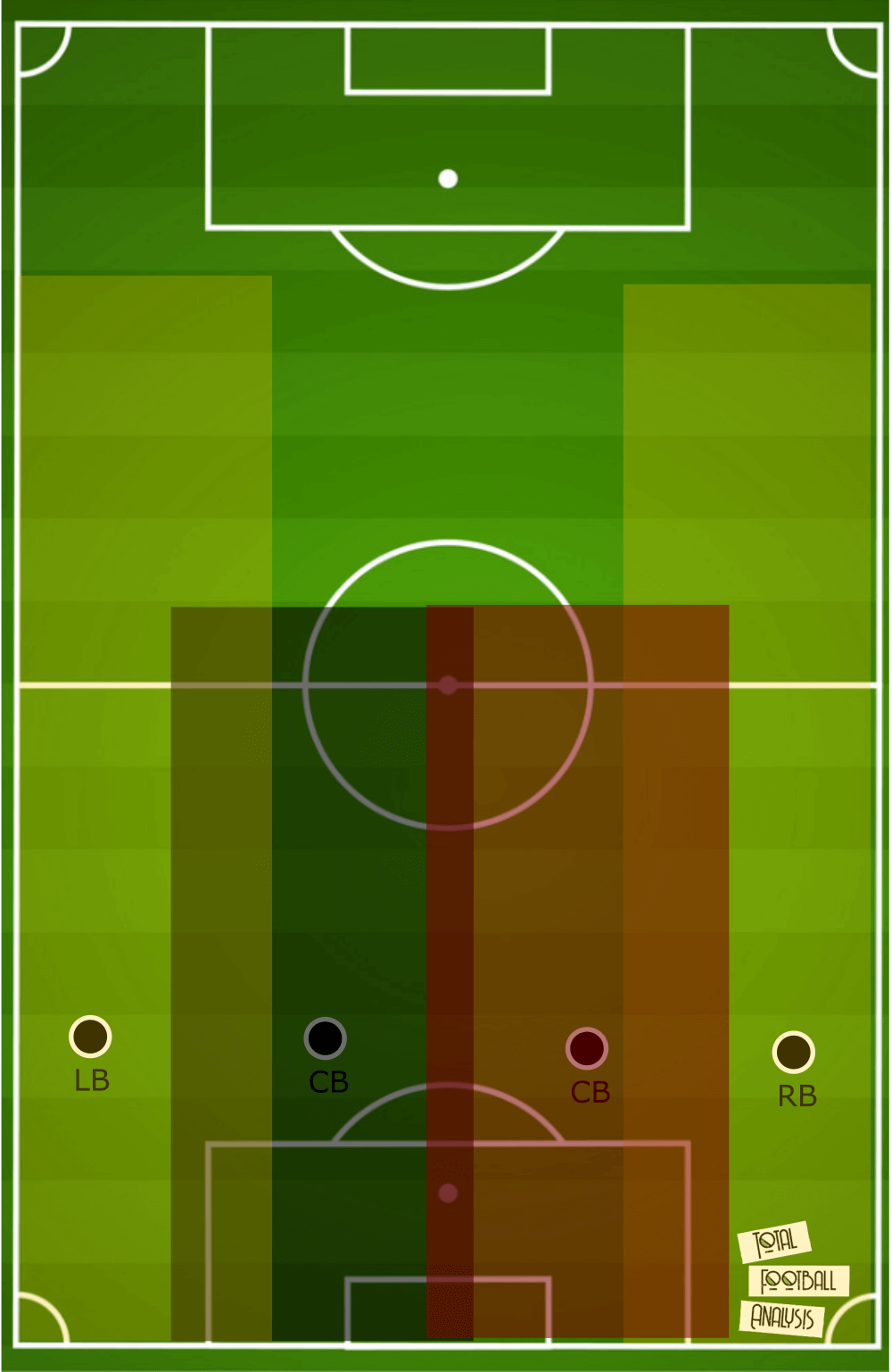
Going higher in the pitch, and analysing the two midfielders, someone can notice that this formation divides the responsibilities among them.
There is a defensive midfielder, that is moving in front of the defensive line and is trying to hold the balance.
For that reason, that player is mostly a strong physical player who can deal with ground and aerial duels.
Moreover, this player, many times, acts as a linking player between the defensive and the offensive line, as he receives the first pass from the back.
There are times when the defensive midfielder will go higher in the field to cover the central midfielder.
The central midfielder is a more technically gifted player.
He has to be strong, physically fit, quick, and with a high level of endurance, as he supports the team with and without the ball all over the field.
He must be a player who can penetrate the opposition, and break lines with his passes, as his team has more chances to win the game if he manages to pass the ball well from midfield.
The image below shows the areas that the two midfielders are covering, depending on their role during a match.
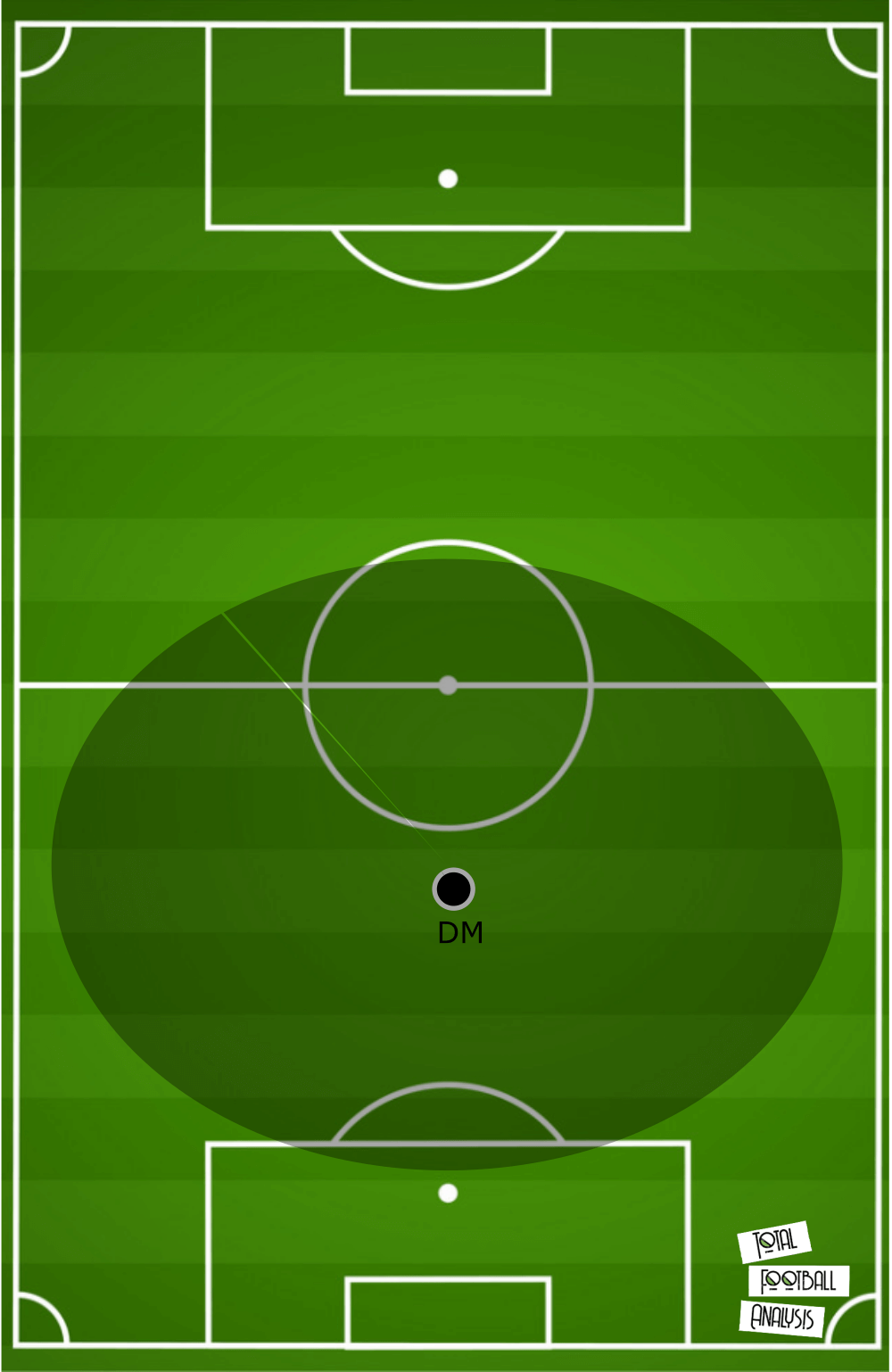
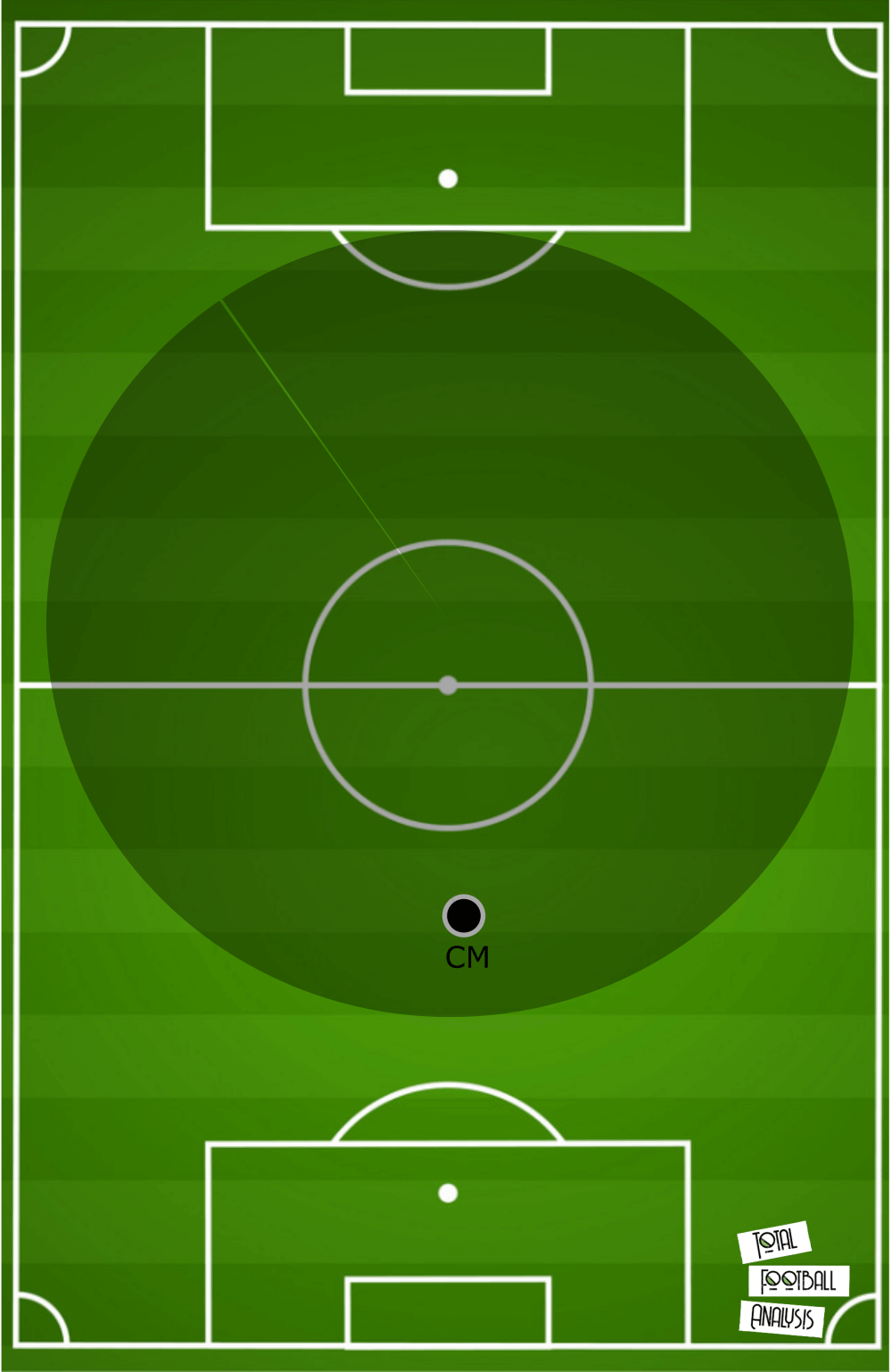
The players that are in the midfield area must be conditioned for endurance, electric speed, and technically gifted.
That will allow them to go engage in 1-vs-1 situations and overcome their opponents.
Specifically, the attacking midfielder must be unpredictable with the ball on his feet.
He must be able to penetrate the opposition’s defensive line.
Moreover, he must know to take advantage of the free space and either drive the ball in there or make a pass.
Overall, the central attacking midfielder or number ’10’ must be a continuous threat to the opposition with and without the ball around the box.
Except for the above, the number ’10’ must be able to defend, as modern football demands him to participate in the game when his team does not have the ball, as well.
The wide attacking midfielders have to be exceptional dribblers and unpredictable.
They must have the ability to deliver the ball into the box and be good at combination play.
They have to read the game and possible scenarios and take advantage of possible weaknesses of the opponent and exploit them.
Without the ball, these players have to support the full-backs defensively.
That is the reason why they have to be in excellent physical condition.
A crucial factor for the success of this formation has to do with the partnership between the full-backs and the wide-attacking midfielders when defending and attacking.
Below there is an image with the areas that the players are moving during a game according to their positions.
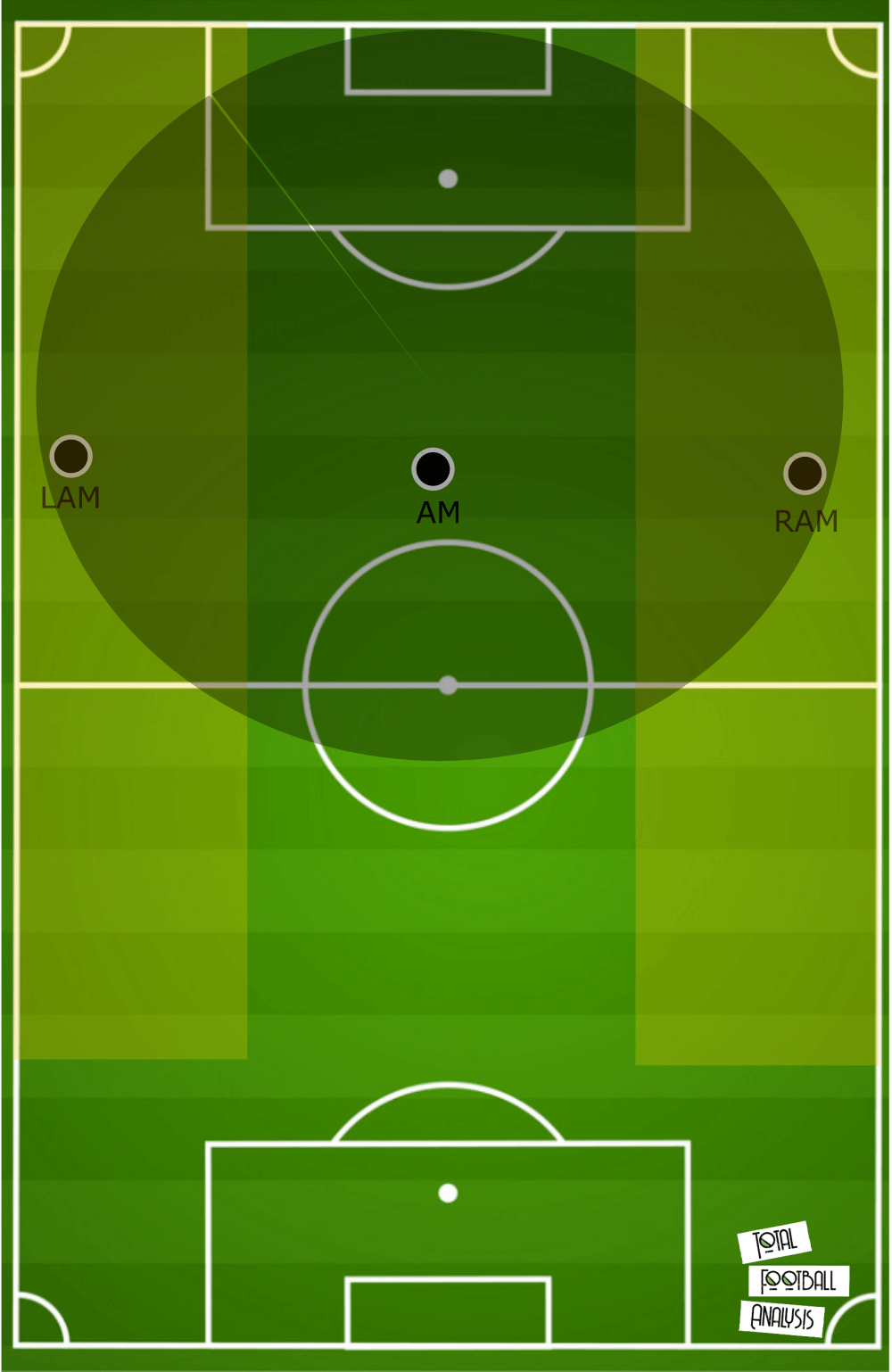
Because of the formation, the centre forward has to be physically strong, and able to receive the ball under instant pressure.
That is because he is the only striker, and for that reason, he has to face two or three defenders.
The striker must be quick with electric pace, and able to read the game to exploit free spaces or take better positioning from the defenders.
He must have the ability to score from different distances and in different ways.
Moreover, he must be able to play away from the box.
In that way, he will support the possessional play and will create spaces that the attacking midfielders can take advantage of.
Specifically, the centre forward and the central attacking midfielder have to cooperate and have excellent communication on the field, as they can exploit the opposition in many different ways, especially by creating free spaces with their movements.
Despite that, the centre forward is the first defender of the team.
For that reason, he must have the physical condition to press high and try to regain the ball.
Below is an image that indicates the area that a centre forward is moving within the 4-2-3-1 formation.
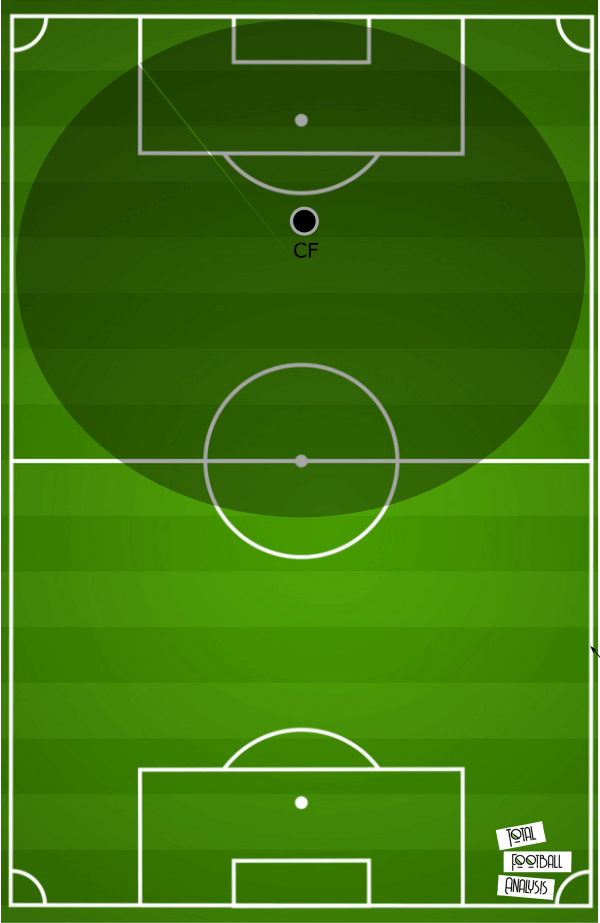
4-2-3-1 Build-up
One of the most common ways that we meet in the teams that are using the 4-2-3-1 formation when they are trying to build up their game from the back, is when the two centre-backs go wide to receive the ball from the keeper.
The full-backs are taking a higher position in the middle third of the field, and usually, the defensive midfielder, is a bit deeper, compared with his partner in that area.
With these movements, the team is trying to stretch the opponent.
By doing the team will gain more space to pass the ball, and eventually move it forward throughout the thirds.
Free space in football means more time.
So, these coordinated movements in the field are crucial for the team to get the ball out of the back safely.
A pass from the goalkeeper to the centre-backs or the defensive midfielder that came deeper seems a reasonable option for the goalkeeper.
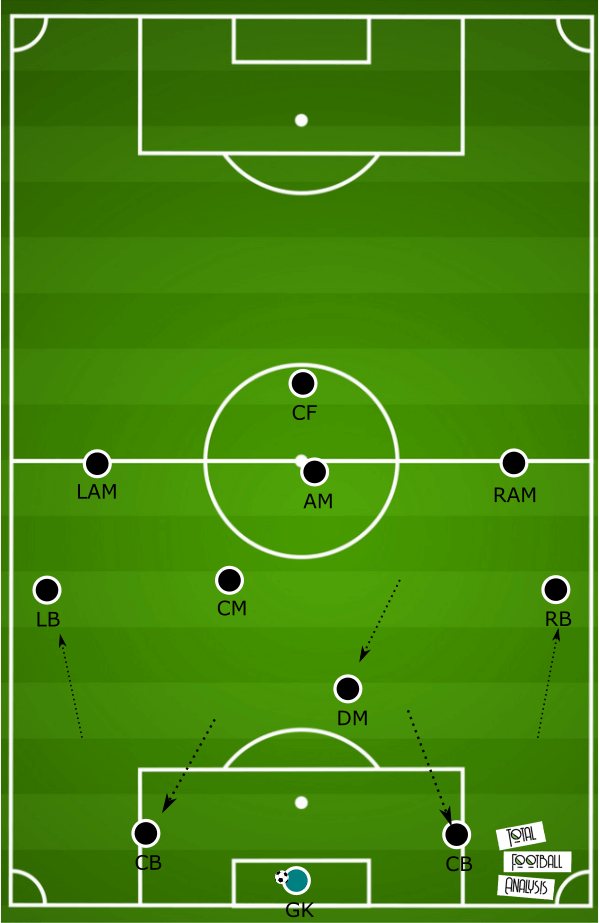
There is always the option for the opponent to press high on the pitch.
On that occasion, and if the opponent is pressing with two strikers, an option would be for the defensive midfielder to drop either among or next to the two centre-backs.
In that way, the team with the 4-2-3-1 formation gets over the numerical disadvantage and has more chances to transfer the ball from the back.
The rest of the players have a similar position as before and try to stretch the opponent’s formation and exploit any possible gaps and weaknesses.
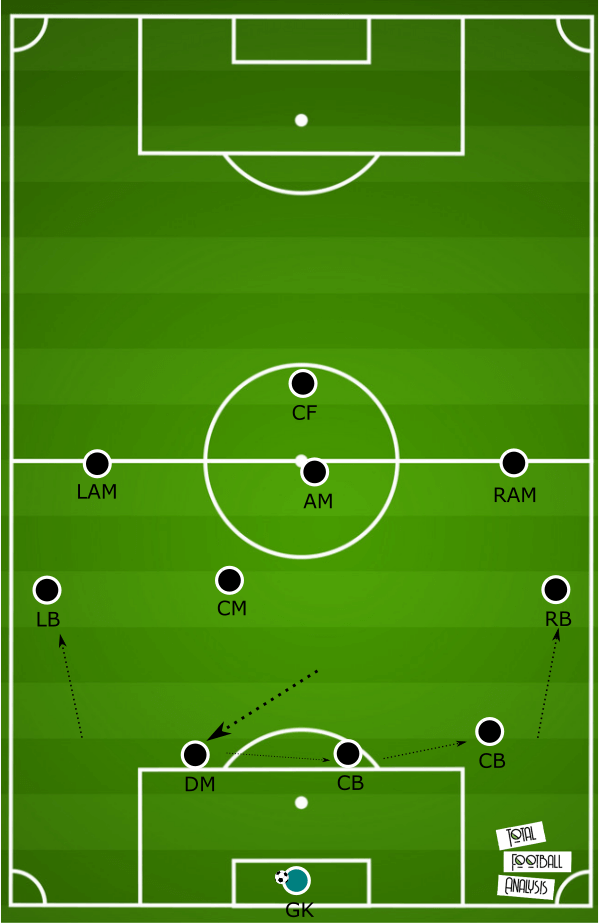
If the opponent adjusts to this change and starts pressing with three players, then the next option could be for a full-back to come deep – next to the final line – and ask for the ball.
In that way he sets a dilemma for the opponent: either one of the opponent’s players is following him, but then there is a lot of free space in between the lines, or no one is following him and letting him receive the ball and starts the possession game.
The defensive midfielder could support him and move to that space where there is a lot of free space.
The full-back’s movement is an interesting move, as we do not see it often.
Moreover, this move could cause problems at the opposition’s high pressure, as the formation is going to be stretched and the team with the 4-2-3-1 formation could exploit the free space.
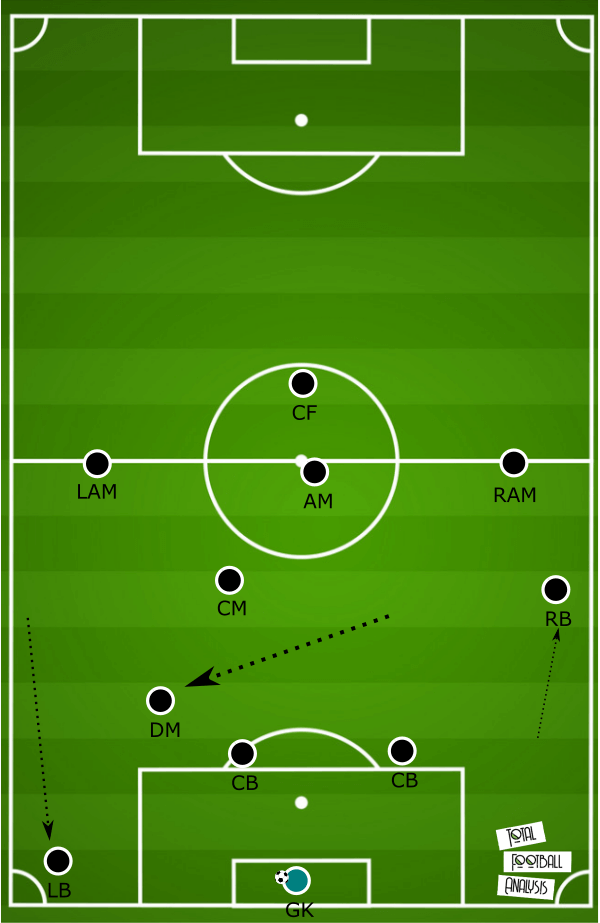
Another option for the goalkeeper, if the opposition adjusts in this scenario, could be a long ball into the wide areas.
Teams that pressure high usually do it with three or four players.
So, if the goalkeeper tries a long ball into the wide areas, to one of the two full-backs, then automatically passes over the opposition’s high defensive block.
The issue then is that the players around the full-back have to support him immediately to retain the possession of the ball and start the possession game from the middle third of the field.
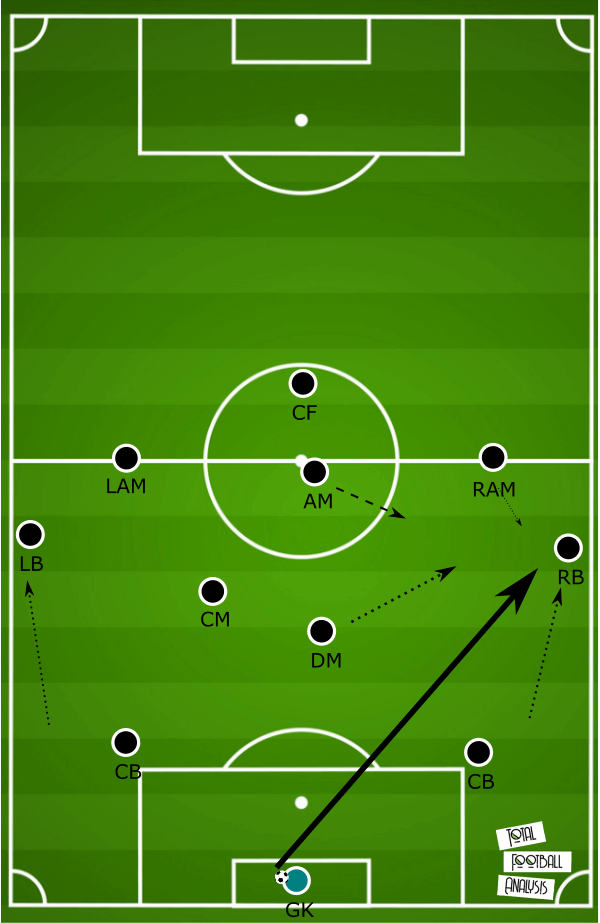
4-2-3-1 Possession throughout the thirds
After the ball has left the goalkeeper, the carrier of it has to transfer it forward.
Supposing that the ball is on the feet of one of the two centre-backs or the full-back, their first job is to make sure that they will not lose the ball in a dangerous area.
The ideal scenario for the carrier of the ball is to pass to the defensive midfielder, who is moving in a deep position.
By doing so, the centre-back will achieve to transfer the ball to a key player.
That will help the team to transfer the ball throughout the thirds.
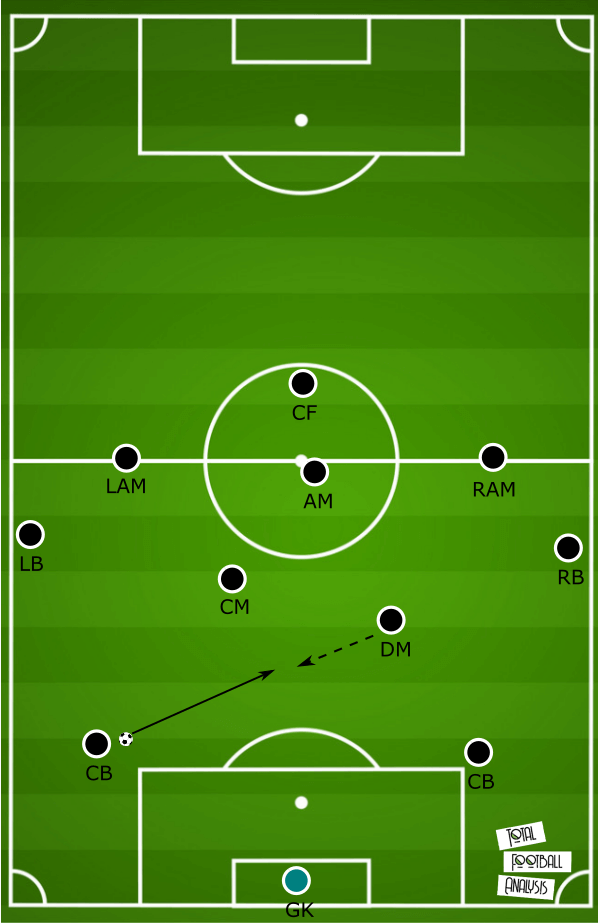
When the defensive midfielder receives the ball, he has several options in different combinations that could lead to a dangerous situation in the opposition’s half.
The first option involves the attacking midfielder, who is positioned in the midfield area: The defensive midfielder passes to him, and he tries to play the ball at the central midfielder, who is positioned a bit deeper and wider in the field.
By transferring the ball back and forth, the players achieve to disorganise the opposition’s defensive structure, as the ball is moving quicker than the players of the opponent can adjust.
When the central midfielder receives the ball, he has to pass it into the wide areas, where the full-back has already started the run to overlap the wide-attacking midfielder.
This quick combination demands the full-backs to have a high position in the field.

The second option is for a team that the manager does not want the full-backs to play in such a high position.
To get the ball into the same area as before, the centre forward must evolve in this scenario: The striker is moving deep in the field to support his teammates while in possession.
In that way, the centre forward not only supports the team but also creates free space in his back that one of his teammates could take advantage of.
The defensive midfielder passes to the centre forward.
The striker tries to find a quick back pass to the attacking midfielder, who supports him in a diagonal position.
The number 10 passes a forward pass to the wide attacking midfielder, who has started his run.
The wide-attacking midfielder can move either wide or take advantage of the free space that the striker created.
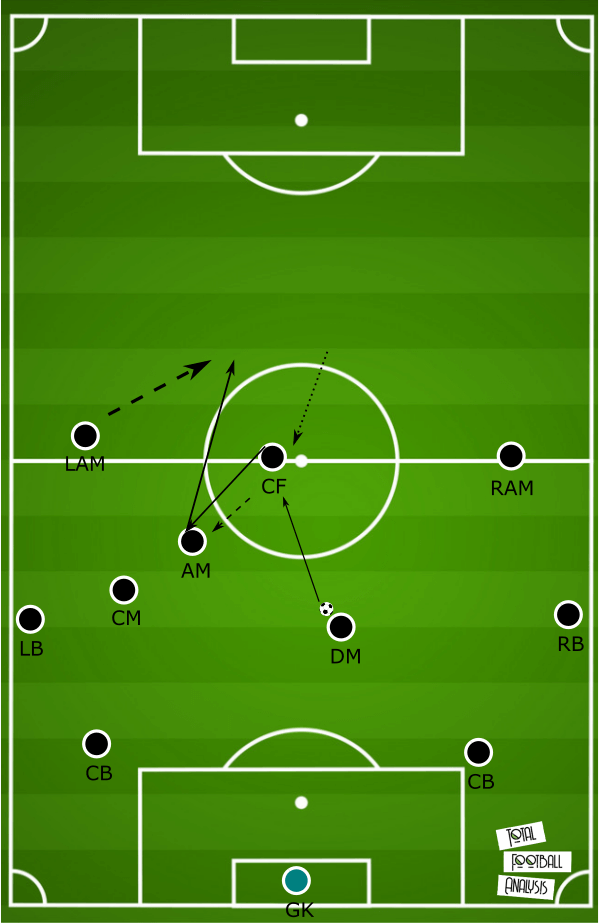
A third option that a team could develop the attack with the 4-2-3-1 formation is with the direct contribution of one of the full-backs.
Some teams try to keep a compact shape when defending, and it is tough for the midfielders to exploit the space.
For that reason, a full-back could step inner in the field and become an extra player.
The defensive midfielder will do a pass at the attacking midfielder.
He is going to pass to the central midfielder who is moving in a diagonal position for instant support, and then he will pass to the full-back, who stepped at the inner axis of the field to overload the area.
The striker in that scenario is a bit higher in the field.
The full-back and the striker will try to have a combination game to transfer the ball to the flanks, where the wide-attacking midfielder has already started his run.
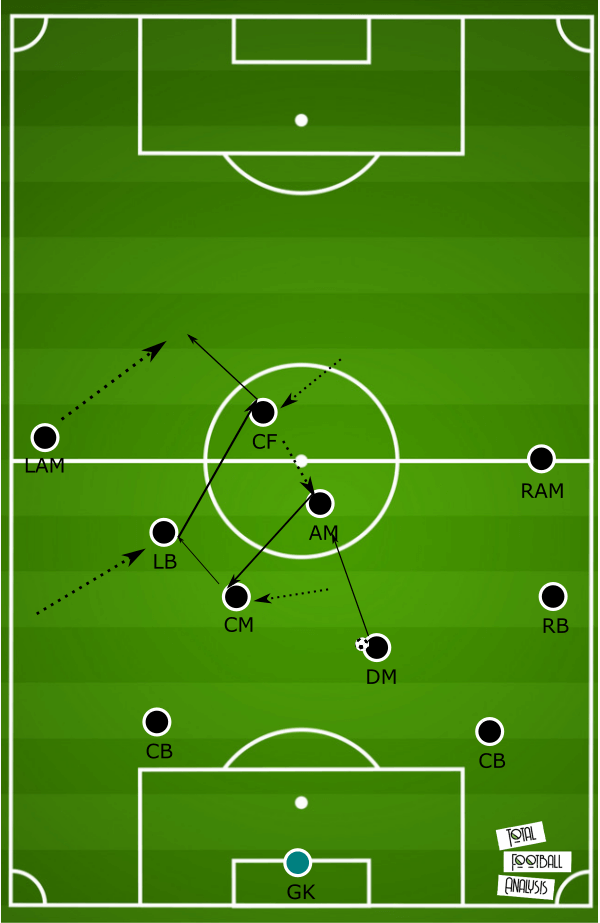
Those were some possible scenarios that could happen when the opposition team is pressing up high.
There will be some teams that will give space and will wait for their opponent with a medium defensive block.
That will give the flexibility to the team to step higher in the field and pressure the opponent with more players in his half.
For example, if a team plays with the full-backs high, they could take a high and wide position in the field, while the wide attacking midfielders would be inner and closer to the opposition’s box.
By taking such a position, the wide attacking midfielders could receive the ball closer to the opponent’s box.
Taking as a fact the characteristics of those players, we could see how dangerous this could be for the opponent.
The only player that is deeper in the field is the defensive midfielder, who tries to retain a balance between the line.
The players that try to break the opponent’s line are the central midfielder and the attacking midfielder that are having a position between the half of the field, and the box.
After this set-up, the formation seems more like a 3-2-5, with many players pushing around the opponent’s box.
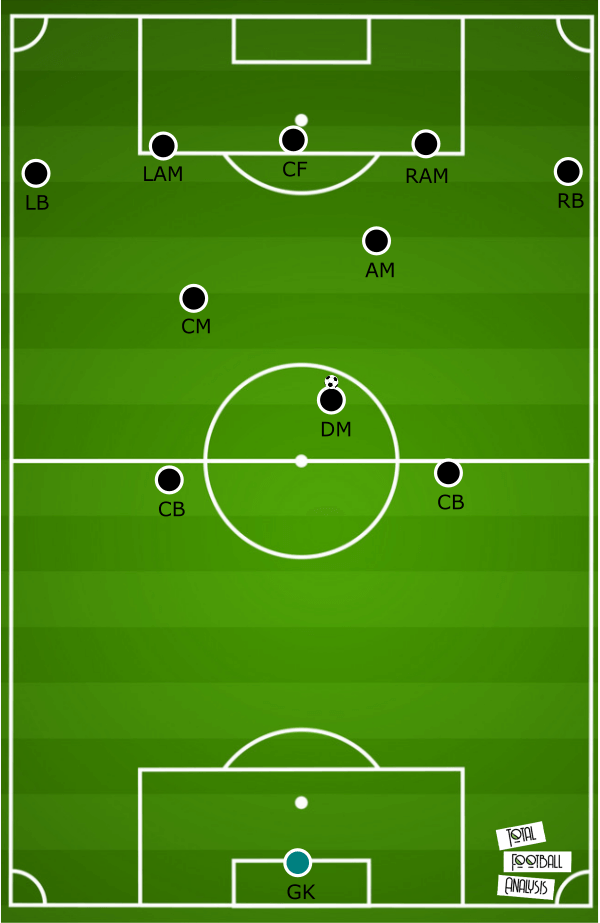
A manager that would not prefer his full-backs high and wide on the pitch probably would choose another set-up: with his full-backs in a deeper position and the wide attacking midfielders in the flanks.
That would give the chance to them to get the ball wide in the field go for 1 vs 1 situations and deliver the ball into the box.
On that set-up, the opposition is getting stretched again, but it is not as aggressive as the previous one, with at least five players in the final third of the field.
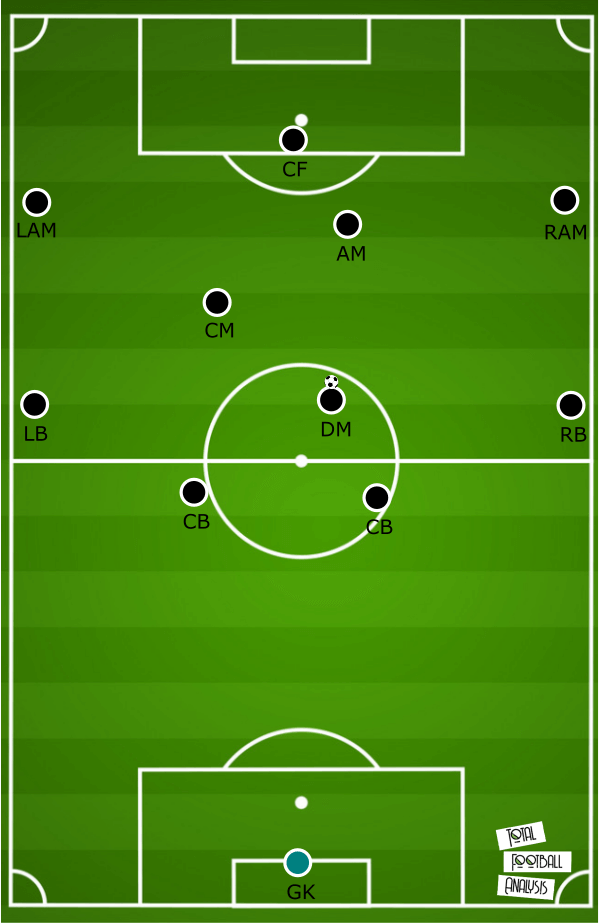
At the final third of the field, the 4-2-3-1 formation provides many different options to finish a chance.
For example, is not only two or three players that can be in the box and try to score a goal.
Depending on the manager’s philosophy, we could get up to five players around the box.
This is a dangerous situation for the opposition to face, as the defenders have to face the striker, the attacking and the wide attacking midfielder, the central midfielder that probably is at the edge of the box, and maybe the full-back that is coming from behind.
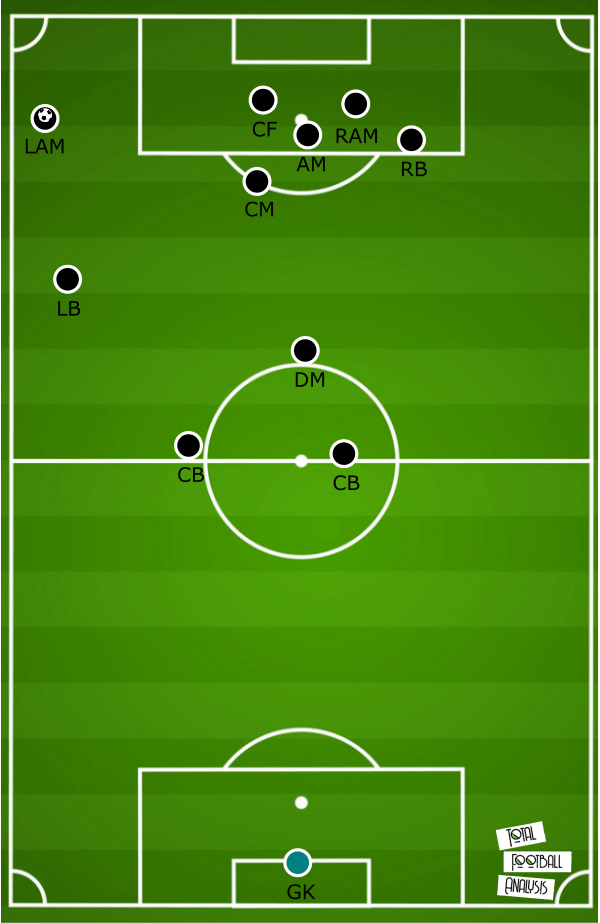
The 4-2-3-1 formation without the ball
The 4-2-3-1 formation is slightly different from the other formation, as it is a formation that has an extra line between the forward and the midfielders.
That is the line with the attacking midfielders.
That gives extra flexibility to the formation especially when a manager has a philosophy to pressure high in the field.
If this is happening, then a manager probably would set up his team very high on the pitch.
To do so, the defensive line has to be around half of the field.
That would put more pressure on the opposition.
The striker, as the first defender has to manipulate the opponent, and drive them with the ball in the space that he wants.
The attacking midfielders are high on the pitch and put instant pressure on whoever receives the ball.
The defensive and central midfielder are marking their players in their space.
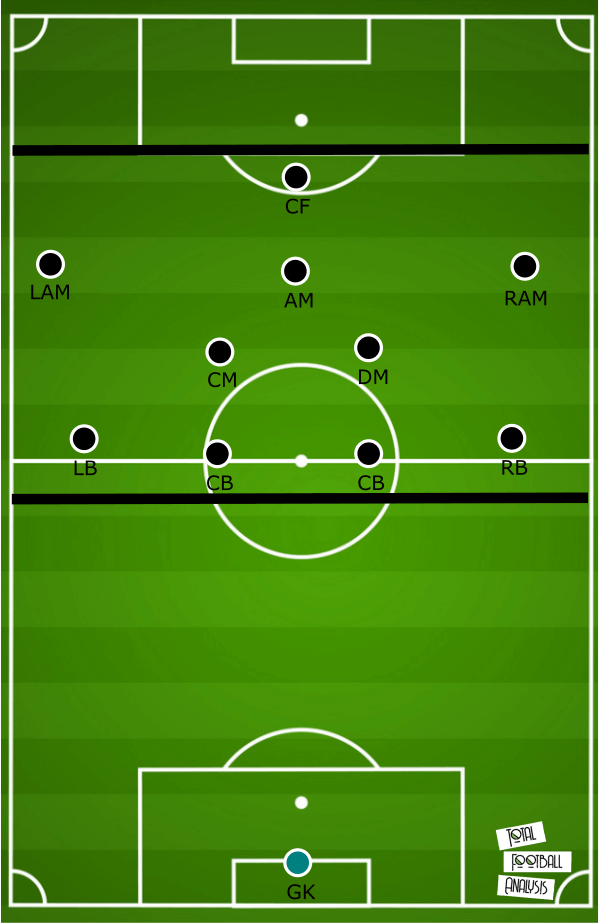
Going a bit deeper in the field, we can see the flexibility that this formation gives: Most of the teams that decide to defend with a medium defensive block, do it by turning the 4-2-3-1 formation, into a 4-4-2.
The attacking midfielder comes next to the striker, while the two wide attacking midfielders step a bit deeper next to the central and defensive midfielders.
That formation is not something standard, as we can see.
For example, if the ball goes at the flanks, then one of the wide-attacking midfielders will step out and will try to push away the carrier of the ball.
So, in that scenario, the 4-4-2 is turning into a 4-3-3, as the midfielders and the other wide attacking midfielder are stepping behind him to support his back.
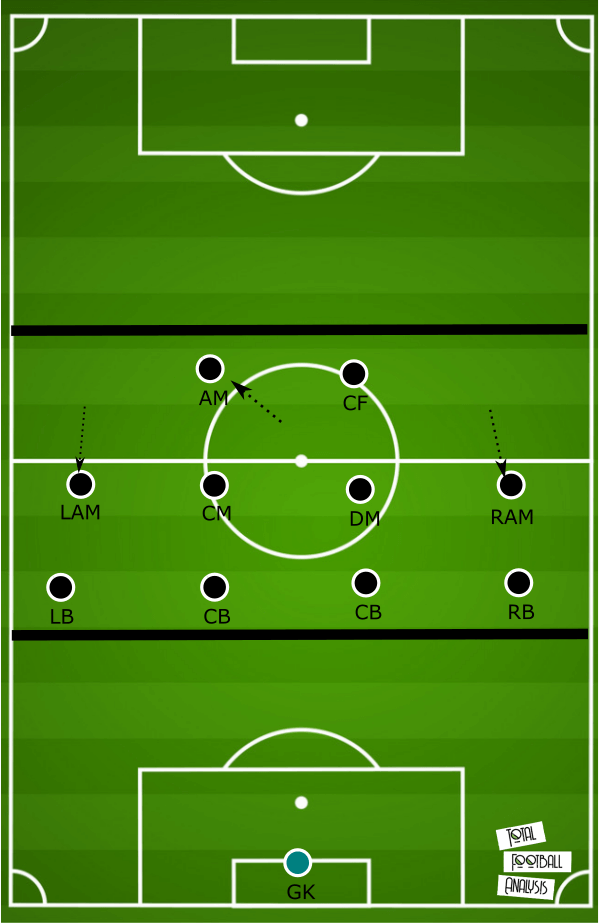
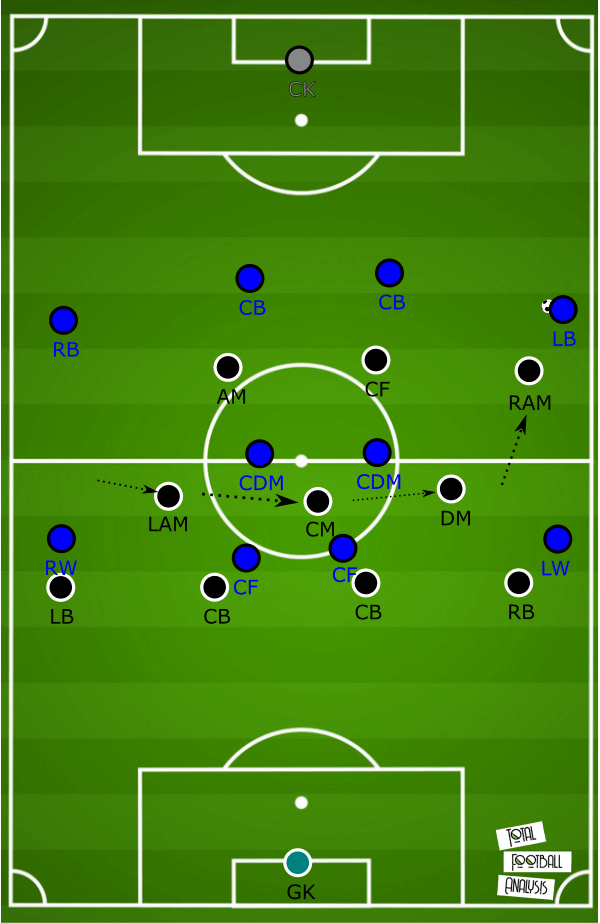
Stepping deeper into the field, this adjustability is becoming more compact.
This is because the players are forming a compact low defensive block from at least eight players, who are at a close distance from each other.
Moreover, the two midfielders that are taking a position in front of the two centre-backs gives the team extra compactness, as four players in the central axis are creating a box in front of the goalkeeper.
In a low defensive block, the only players that are a bit higher on the pitch are the attacking midfielder and the centre-forward to counterattack.
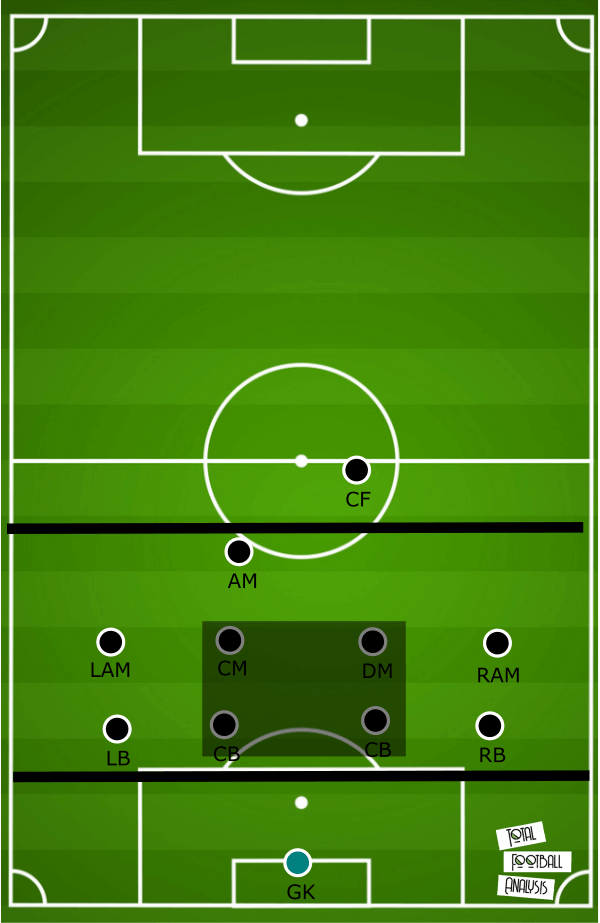
Conclusion
The 4-2-3-1 formation is a tactical shape that gives a lot of options to the managers, and this is the reason why it is so popular in modern football.
We saw many managers with different philosophies use it.
Some managers prefer to defend and counterattack, while others to dominate in the field, but both have used this formation with great success.
This is something that shows the great flexibility of this formation.





Comments